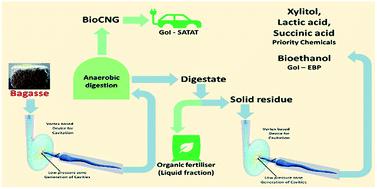当前位置:
X-MOL 学术
›
Sustain. Energy Fuels
›
论文详情
Our official English website, www.x-mol.net, welcomes your
feedback! (Note: you will need to create a separate account there.)
Sugarcane bagasse based biorefineries in India: potential and challenges
Sustainable Energy & Fuels ( IF 5.0 ) Pub Date : 2020-11-10 , DOI: 10.1039/d0se01332c Kakasaheb S. Konde 1, 2, 3, 4 , Sanjay Nagarajan 5, 6, 7, 8 , Vinod Kumar 8, 9, 10 , Sanjay V. Patil 1, 2, 3, 4 , Vivek V. Ranade 5, 6, 7, 8
Sustainable Energy & Fuels ( IF 5.0 ) Pub Date : 2020-11-10 , DOI: 10.1039/d0se01332c Kakasaheb S. Konde 1, 2, 3, 4 , Sanjay Nagarajan 5, 6, 7, 8 , Vinod Kumar 8, 9, 10 , Sanjay V. Patil 1, 2, 3, 4 , Vivek V. Ranade 5, 6, 7, 8
Affiliation

|
Sugarcane bagasse (SCB) is one of the world's most abundant agricultural residues and in an Indian context, ∼100 million tonnes per annum is produced. The current use of SCB is restricted to the cogeneration of steam and power; however considering its potential, cogeneration is not the best valorisation route. Furthermore, with falling electricity prices and reducing global sugar prices due to excess sugar stock, it is inevitable that the waste generated (SCB) by sugar mills are utilised for generating revenue sustainably. With this background, this review aims to put forth a biorefinery perspective based on SCB feedstock. Biogas and bioethanol are the Government of India's current focus with policies and subsidies clearly pointing towards a sizeable future market. Therefore, alongside these biofuels, high-value chemicals such as xylitol, succinic acid and lactic acid were identified as other desired products for biorefineries. This review firstly discusses SCB pre-treatment options based on end applications (saccharification or anaerobic digestion, AD). Next, state-of-the-art for each of these aspects was reviewed and our perspective on a profitable biorefinery is presented. We propose an AD based biorefinery where vortex-based hydrodynamic cavitation was found to be the best choice for pre-treatment. AD is considered not only a bioprocess for energy production here but also a ‘pre-treatment’, where partial conversion of holocellulose leads to a digestate rich in a loosened fibre matrix. This digestate rich in cellulose can be enzymatically hydrolysed and further valorised biochemically. This approach would be cost effective and provide a sustainable waste management route for sugar mills.
中文翻译:

印度基于甘蔗渣的生物精炼厂:潜力和挑战
甘蔗渣(SCB)是世界上最丰富的农业残渣之一,在印度,年产量约为1亿吨。SCB的当前使用仅限于蒸汽和动力的热电联产。但是考虑到其潜力,热电联产并不是最佳的增值途径。此外,随着电价的下跌和由于过多的糖库存而导致的全球糖价的下降,不可避免的是,制糖厂产生的废物(SCB)被用于可持续地产生收入。在此背景下,本综述旨在提出基于SCB原料的生物精炼观点。沼气和生物乙醇是印度政府目前的重点,其政策和补贴显然指向未来的广阔市场。因此,除了这些生物燃料之外,木糖醇等高价值化学品,丁二酸和乳酸被确定为生物精炼厂的其他所需产品。本文首先讨论了基于最终应用(糖化或厌氧消化,AD)的SCB预处理方案。接下来,对这些方面的最新技术进行了回顾,并提出了我们对可盈利的生物精炼厂的看法。我们提出了一种基于AD的生物精炼厂,其中基于涡流的水力空化被认为是进行预处理的最佳选择。在这里,AD不仅被认为是用于产生能量的生物过程,而且被认为是“预处理”,其中全纤维素的部分转化导致消化物中富含疏松的纤维基质。该富含纤维素的消化物可以被酶水解并进一步生化地增值。
更新日期:2020-11-25
中文翻译:

印度基于甘蔗渣的生物精炼厂:潜力和挑战
甘蔗渣(SCB)是世界上最丰富的农业残渣之一,在印度,年产量约为1亿吨。SCB的当前使用仅限于蒸汽和动力的热电联产。但是考虑到其潜力,热电联产并不是最佳的增值途径。此外,随着电价的下跌和由于过多的糖库存而导致的全球糖价的下降,不可避免的是,制糖厂产生的废物(SCB)被用于可持续地产生收入。在此背景下,本综述旨在提出基于SCB原料的生物精炼观点。沼气和生物乙醇是印度政府目前的重点,其政策和补贴显然指向未来的广阔市场。因此,除了这些生物燃料之外,木糖醇等高价值化学品,丁二酸和乳酸被确定为生物精炼厂的其他所需产品。本文首先讨论了基于最终应用(糖化或厌氧消化,AD)的SCB预处理方案。接下来,对这些方面的最新技术进行了回顾,并提出了我们对可盈利的生物精炼厂的看法。我们提出了一种基于AD的生物精炼厂,其中基于涡流的水力空化被认为是进行预处理的最佳选择。在这里,AD不仅被认为是用于产生能量的生物过程,而且被认为是“预处理”,其中全纤维素的部分转化导致消化物中富含疏松的纤维基质。该富含纤维素的消化物可以被酶水解并进一步生化地增值。











































 京公网安备 11010802027423号
京公网安备 11010802027423号